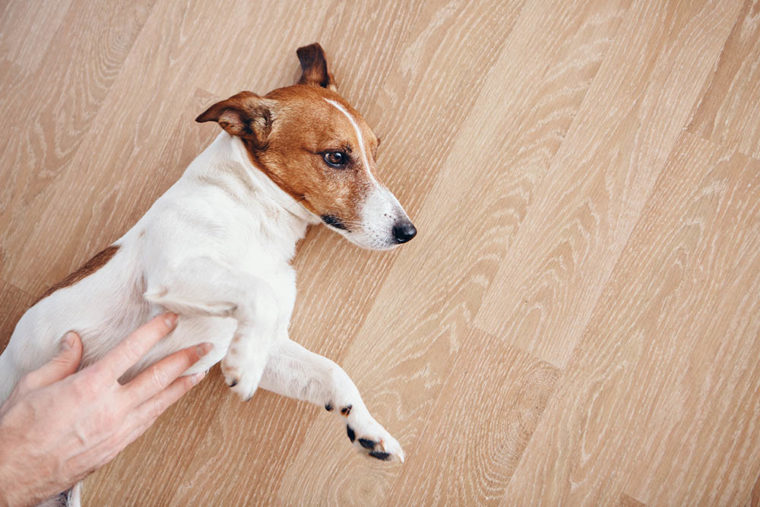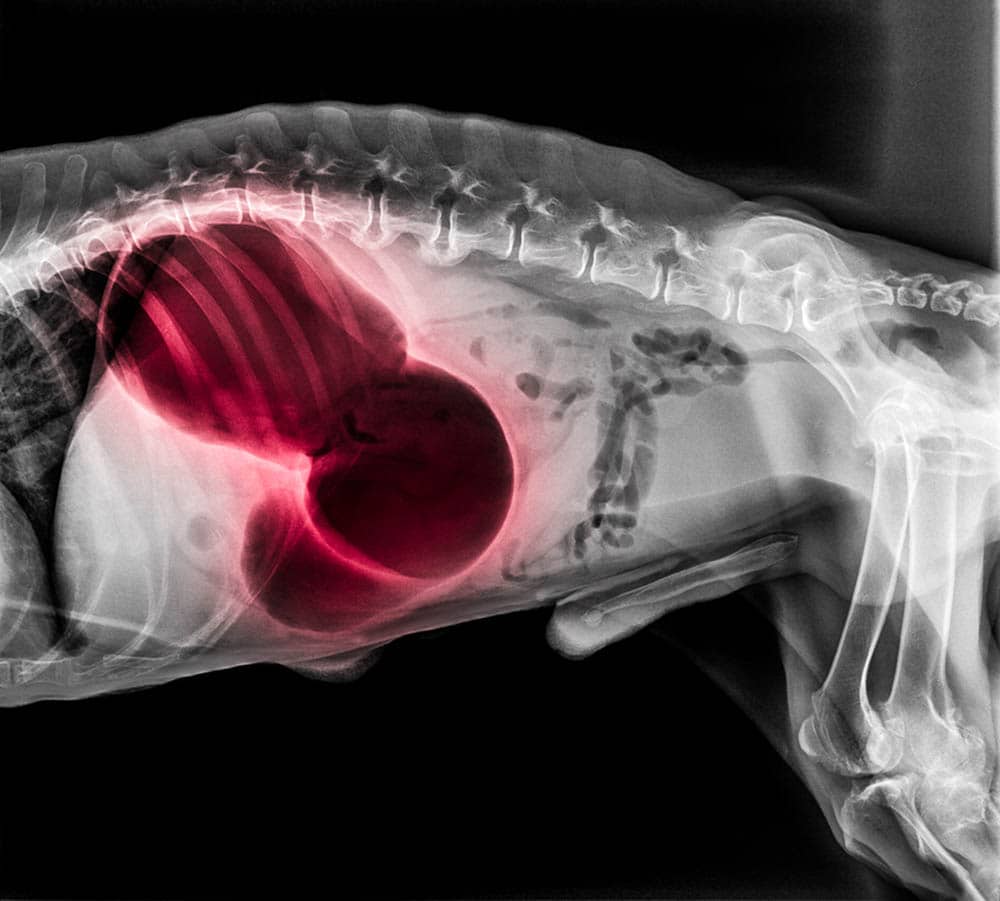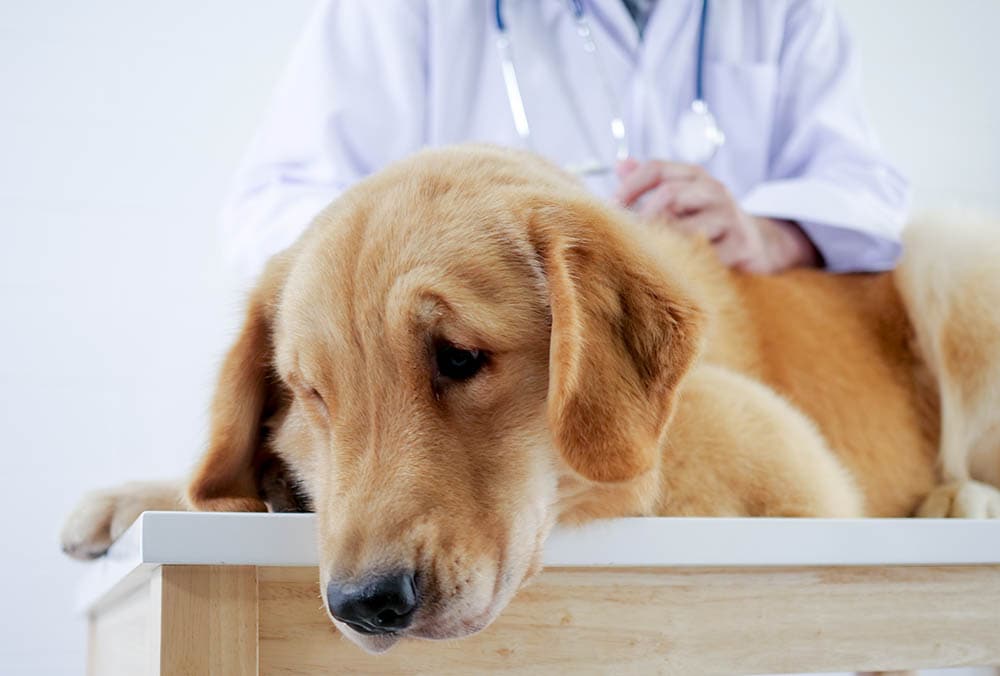
Has your dog been acting strange lately? Do you notice their stomach a little more distended than usual? Is their belly hard to the touch? If you answered ‘yes’ to any of these questions, you need to keep reading.
A swollen or hard stomach in dogs is not something that you should brush off. These symptoms could be indicative of very serious and life-threatening conditions. When it comes to the health of our dogs, you can never be too careful. It’s better to err on the side of caution than to just cross your fingers and hope that your dog will heal on their own.
There are factors to take into consideration before worrying; age of your pet, recent illness or surgery, are they unwell, painful, have they just been fed, did they break into the food bin and eat a whole bag of food!
Keep reading to learn everything you need to know about some of the more serious causes of dog stomach hardness like what’s causing it, how to prevent it, and what your vet can do to help.
Causes of a Hard Stomach in Dogs
1. Gastric Dilation Volvulus
Gastric Dilation Volvulus (GDV), or bloat, is a very serious and often fatal condition that happens when gas or food stretches a dog’s stomach. The bloated stomach then rotates, trapping that gas inside, and prohibiting blood flow. The gas continues to build up and if left untreated, GDV can take your dog’s life within a few short hours.
Symptoms of GDV to be on the lookout for include:
Risk Factors of GDV
There doesn’t appear to be one specific reason why GDV will sometimes happen. There are some things, though, that can increase your dog’s risk of getting it.
How they eat their food can play a part in causing GDV. If they eat too fast, only have one big meal a day, or use a lifted food bowl, their risk of getting GDV can be higher.
Large and deep-chested dog breeds are also more prone to GDV. This includes Great Danes, Saint Bernards, Standard Poodles, and Doberman Pinschers, among others. It’s important to note, however, while some breeds can be predisposed to this condition, it can occur in any breed and in dogs of any size. Those of anxious or unhappy temperament also thought to be at more risk.
Studies suggest dogs that weigh over 100 pounds have a 20% risk of experiencing bloat during their lifetime.
What to Do About GDV
If you suspect your pup is suffering from GDV, you need to go to a veterinarian as soon as you can as it is a life threatening emergency. Your vet can decompress the stomach to release the gas. They will try to pass a stomach tube to relieve the pressure on the stomach wall. If that doesn’t work, your vet may need to insert a catheter through the skin into their stomach.
Once your dog’s heart rate and breathing have been deemed stable, your vet will most likely need to perform surgery. The primary goal of this surgery is to return the stomach to the position it’s intended to be in as well as remove any dead or dying tissues damaged by the poor blood flow.
Preventing GDV
Preventing GDV can be difficult since there are so many different things that cause it. There are some things you can do to decrease your pup’s risk, though.
Feed him two or more meals every day and be sure to include canned food as well as dry food. One study suggested that including both types of food can reduce the risk of GDV by 59% but further work is needed. Use a food bowl that encourages slower eating if you know your dog tends to scarf down their meals. Don’t use an elevated food bowl unless your pup has other health problems (like megaesophagus) that make this type of bowl necessary.
Don’t exercise directly after feeding, leave a minimum of 30 minutes, and preferably 2 hours.
Some vets may suggest a gastropexy for high-risk dog breeds. This is a preventative surgical procedure where the stomach gets attached to the body wall. Gastropexy won’t prevent bloating, but it can prevent twisting most of the time.

2. Peritonitis
Another potential cause of your dog’s stomach hardness is peritonitis. This condition is an inflammation of the membrane that lines your dog’s abdominal cavity. Like GDV, it is serious and potentially life-threatening. Peritonitis can be caused by several things such as a puncture in your dog’s stomach, splinters, gallbladder or urinary bladder ruptures, pancreatitis or tumors.
Peritonitis is very painful and a serious illness so there will be many signs that your dog is unwell. As well as a painful abdomen other symptoms to watch for include:
Risk Factors of Peritonitis
There doesn’t appear to be any particular risk factors for peritonitis. The most common cause is a bacterial infection that is introduced into your dog’s abdomen via an external wound or perforation of an internal organ.
A perforation in the stomach or intestinal ulcers that cause peritonitis can occur as a result of an adverse reaction to specific types of medication such as steroids.
What to Do About Peritonitis
If your dog has any of the above symptoms, your vet will perform specific tests to determine what the cause is. They will check the abdominal cavity for inflammation and fluid build. They will also take an abdominal fluid sample and a culture to determine what type of bacteria is causing the infection, as well as a blood count, an ultrasound, or a biochemical profile via bloodwork.
Once your vet has determined that peritonitis is the cause of your dog’s symptoms, their priority will be to stabilize the consequences of the infection. They may first treat any changes in your dog’s electrolytes, fluid loss, and shock. Your dog will also be put on antibiotics to fight the infection and medication to reduce any inflammation.
Once your dog is stabilized, surgery may be necessary.
Preventing Peritonitis
Since there are so many causes of peritonitis, there isn’t one simple thing a pet owner can do to prevent the disease and thankfully it is not a common illness.
One way to reduce your dog’s risk is to keep all non-edible things your dog has shown interest in out of sight. Foreign body ingestion is one of the main causes of peritonitis, so if you know your dog likes to eat non-food objects, you need to do your due diligence to make your home safe for him.
3. Cushing’s Syndrome
Hyperadrenocorticism, also known as Cushing’s syndrome, is another potential cause for your dog’s pot belly. This condition happens when your dog’s body creates an excessive amount of the hormone cortisol. Cortisol is the chemical that allows dogs (and humans) to respond to stress, fight infections, and control their weight. There needs to be a perfect balance of cortisol as if there’s too much or too little of it, problems can occur.
Cushing’s syndrome can be a bit trickier to diagnose as its symptoms are similar to that of other conditions. Your pup could have hyperadrenocorticism if he’s exhibiting these symptoms:
Risk Factors of Cushing’s Syndrome
This study suggests that several risk factors may make your pup more susceptible to Cushing’s syndrome but it is not a common illness, roughly 0.2% of pets seen in general practice. Female dogs may be more likely to have this condition than their male counterparts.
The median age at the time of diagnosis was 10.9 years, suggesting this condition happens most often in older pets.
Jack Russell Terriers, Staffordshire Bull Terriers, and Bichon Frise were the most commonly diagnosed breeds.
Canine obesity also seems to be a risk factor for this condition.
What to Do About Cushing’s Syndrome
If you suspect your pup might have this condition, you’ll need to see a vet to confirm a diagnosis.
Your vet will run tests like the ACTH stimulation or the LDDS test. The ACTH test requires a blood sample followed by a dose of adrenocorticotropic hormone. After the dose of ACTH, a second blood test will be taken to check for a significant increase in cortisol. The LDDS test is similar as a preliminary blood sample will be drawn followed by an injection of dexamethasone. After a second blood draw, your vet will look to see if your dog’s cortisol levels don’t drop as it is then likely your pup has a tumor that’s preventing his body from properly responding to the medication.
Your vet might also request an ultrasound to see if there are any tumors.
There are different treatment options based on the type of Cushing’s disease your pup has. Pituitary dependent, the most common form, is most often treated with medications. Adrenal Dependent Cushing’s can call for surgery to remove the tumor on your dog’s adrenal gland. The third type of Cushing’s, Iatrogenic Cushing’s disease, is easy to treat by tapering your dog off of the steroid medication that’s causing the condition.
Preventing Cushing’s Syndrome
Unfortunately, there is no way to prevent Cushing’s syndrome if it’s caused by tumors.
Iatrogenic Cushing’s can be prevented by limiting your pup’s exposure to steroid medication.

4. Ascites
The final main cause of a hard stomach in dogs is ascites. Ascites is the medical term that refers to the build-up of abdominal fluid. It can be caused by several diseases and conditions including heart failure, kidney disease, or intestinal disease.
If your dog has ascites, you may notice the following symptoms:
Risk Factors of Ascites
Several medical problems will make your dog more vulnerable to ascites. These conditions include:
What to Do About Ascites
A trip to the vet is in order if you believe your dog might have ascites. Your vet will begin with a physical examination which will include a fluid thrill test to see if there is a fluid wave present in his abdomen. Often the abdominal distension occurs over time and may not initially be hard until there is a large volume of fluid. He may order an ultrasound to confirm that there is fluid in the abdomen and will collect blood samples for testing.
Your vet may collect the abdominal fluid with a syringe to test for abnormalities and to determine if any bacteria or fungus is causing the ascites.
You may need to put your dog on a low-sodium diet. Your vet might choose to use diuretics to help eliminate the excess sodium faster.
The cause of ascites will need to be treated. The treatment method used will depend on what is causing the excess fluid in the first place. It can include medications, surgery, and replacements of fluids.
Preventing Ascites
There are many different causes of ascites in dogs, so it is difficult to prevent it. The best thing you can do is to keep your dog healthy through a proper diet and regular exercise and keep up with regular vet visits so you can catch conditions and diseases before they have a chance to further develop.
Can Other Things Cause a Hard Stomach?
The above four conditions aren’t the only things that can cause your dog to have a hard stomach, but they are the most common. Internal bleeding from trauma or ruptured masses, blockages, and tumors can mimic some of the above symptoms, too. In younger pups, less worrying things, such as roundworm infection, can cause abdominal swelling.
A hard stomach isn’t always an immediate cause for concern but should warrant further monitoring as the above serious conditions will have other symptoms and for the first two will require rapid veterinary attention.

How Can I Prevent Stomach Problems in My Dog?
While certain conditions can’t be prevented, there are several things pet owners can do to keep their dogs in tip-top shape to lessen the likelihood of stomach issues.
Take your dog in to see his vet regularly. The vet can then keep tabs on his overall health, as well as take a closer look at his organs to establish a baseline. Regular check-ups will also remind you to stay up-to-date on all of your dog’s vaccinations and parasite prevention measures.
Feed your dog a well-balanced and high-quality diet that’s appropriate for their age and health status. Try to limit how often you’re giving table scraps.
Don’t allow your pup into places where there might be things that would harm him. Keep garbage and household toxins like cleaning chemicals well out of reach. Research indoor plants before bringing them home to ensure they’re pet-safe. Make sure the toys you’re giving him don’t have any small components that could break off and cause blockages.
Conclusion
A hard stomach on your dog can be a concerning finding and it’s not something that you should take lightly. We always recommend taking your pet to the vet if there is any doubt about their health. A hard and distended tummy is no exception to this rule.
Make an appointment with your vet to have them give your dog a once-over. There’s a chance they could just be fat, or it could be something serious, like GVD, so take care to notice any other symptoms. Err on the side of caution and get your pup seen by their vet just to be sure.
Related dog reads:
- What to Give a Dog for an Upset Stomach — 10 Great Options
- How Much Does an Emergency Vet Cost for Dogs? (2023 Update)
- Braces for Dogs — Effectiveness and Costs (2023 Update)
Featured Image Credit: Tursk Aleksandra, Shutterstock







